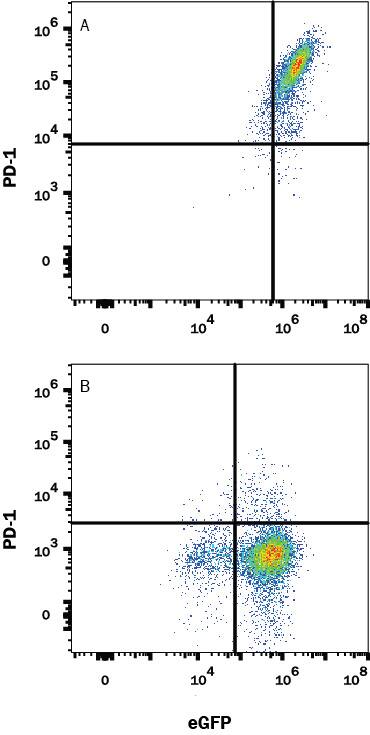Mouse PD-1 Antibody
R&D Systems, part of Bio-Techne | Catalog # MAB77381


Conjugate
Catalog #
Key Product Details
Species Reactivity
Mouse
Applications
CyTOF-ready, Flow Cytometry, Western Blot
Label
Unconjugated
Antibody Source
Monoclonal Rat IgG2A Clone # 996221
Product Specifications
Immunogen
Mouse myeloma cell line, NS0-derived mouse PD-1
Met1-Gln167
Accession # Q02242
Met1-Gln167
Accession # Q02242
Specificity
Detects mouse PD-1 in direct ELISAs.
Clonality
Monoclonal
Host
Rat
Isotype
IgG2A
Scientific Data Images for Mouse PD-1 Antibody
Detection of mouse PD‑1 by Western Blot.
Western blot shows lysates of EL-4 mouse lymphoblast cell line. PVDF membrane was probed with 2 µg/mL of Rat Anti-Mouse PD-1 Monoclonal Antibody (Catalog # MAB77381) followed by HRP-conjugated Anti-Rat IgG Secondary Antibody (Catalog # HAF005). Specific bands were detected for PD-1 at approximately 55 kDa (as indicated). This experiment was conducted under reducing conditions and using Immunoblot Buffer Group 1.Detection of PD-1 in HEK293 Human Cell Line Transfected with Mouse PD-1 and eGFP by Flow Cytometry.
HEK293 human embryonic kidney cell line transfected with either (A) mouse PD-1 or (B) irrelevant transfectants and eGFP was stained with Rat Anti-Mouse PD-1 Monoclonal Antibody (Catalog # MAB77381) followed by APC-conjugated Anti-Rat IgG Secondary Antibody (Catalog # F0113). Quadrant markers were set based on isotype control antibody staining (Catalog # MAB006). View our protocol for Staining Membrane-associated Proteins.Applications for Mouse PD-1 Antibody
Application
Recommended Usage
CyTOF-ready
Ready to be labeled using established conjugation methods. No BSA or other carrier proteins that could interfere with conjugation.
Flow Cytometry
0.25 µg/106 cells
Sample: HEK293 Human Cell Line Transfected with Mouse PD-1
Sample: HEK293 Human Cell Line Transfected with Mouse PD-1
Western Blot
2 µg/mL
Sample: EL‑4 mouse lymphoblast cell line
Sample: EL‑4 mouse lymphoblast cell line
Formulation, Preparation, and Storage
Purification
Protein A or G purified from hybridoma culture supernatant
Reconstitution
Reconstitute at 0.5 mg/mL in sterile PBS. For liquid material, refer to CoA for concentration.
Formulation
Lyophilized from a 0.2 μm filtered solution in PBS with Trehalose. *Small pack size (SP) is supplied either lyophilized or as a 0.2 µm filtered solution in PBS.
Shipping
Lyophilized product is shipped at ambient temperature. Liquid small pack size (-SP) is shipped with polar packs. Upon receipt, store immediately at the temperature recommended below.
Stability & Storage
Use a manual defrost freezer and avoid repeated freeze-thaw cycles.
- 12 months from date of receipt, -20 to -70 °C as supplied.
- 1 month, 2 to 8 °C under sterile conditions after reconstitution.
- 6 months, -20 to -70 °C under sterile conditions after reconstitution.
Background: PD-1
References
- Ishida, Y. et al. (1992) EMBO J. 11:3887.
- Sharpe, A.H. and G.J. Freeman (2002) Nat. Rev. Immunol. 2:116.
- Coyle, A. and J. Gutierrez-Ramos (2001) Nat. Immunol. 2:203.
- Nishimura, H. and T. Honjo (2001) Trends Immunol. 22:265.
- Latchman Y. et al. (2001) Nat. Immun. 2:261.
- Tamura, H. et al. (2001) Blood 97:1809.
Long Name
Programmed Death-1
Alternate Names
CD279, PD1, PDCD1, SLEB2
Entrez Gene IDs
Gene Symbol
PDCD1
UniProt
Additional PD-1 Products
Product Documents for Mouse PD-1 Antibody
Product Specific Notices for Mouse PD-1 Antibody
For research use only
